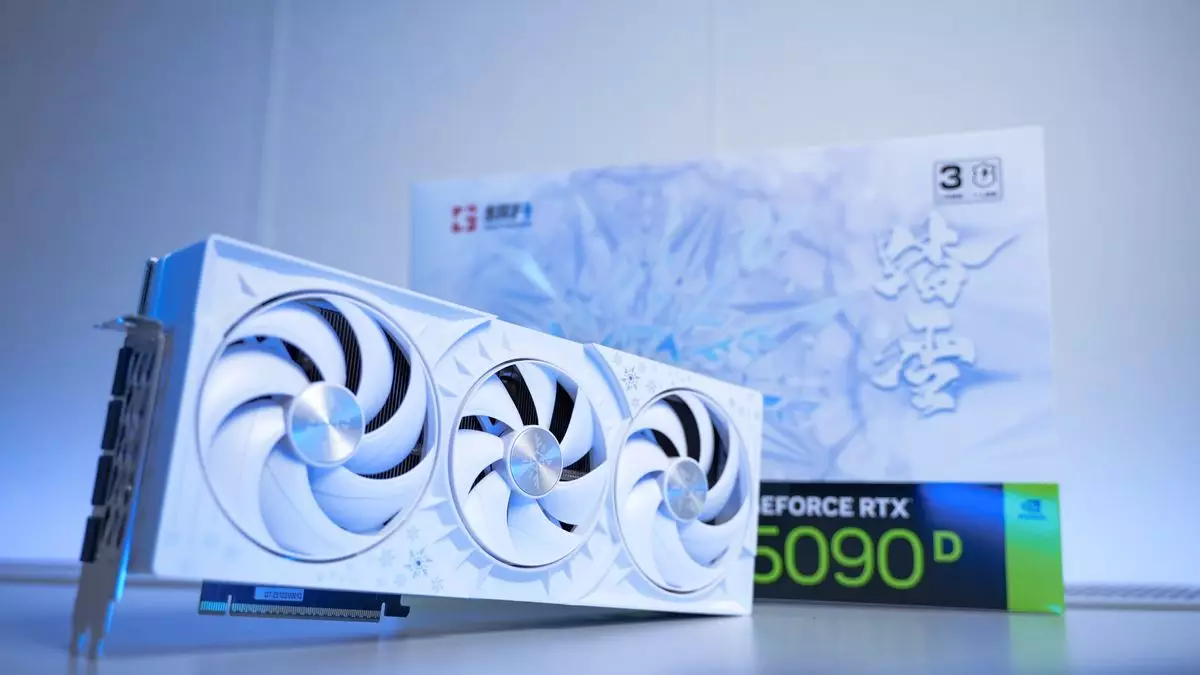The anticipated launch of Nvidia’s RTX 50 series graphics cards has created significant buzz in the gaming and tech communities. Among the offerings set to turn heads is the visually striking Gainward RTX 5090 D, notable for its frosty white design and whimsical snowflake motifs. However, while its aesthetic appeal may enchant many enthusiasts, a deeper dive into its specifications reveals a complex narrative about performance limitations and market dynamics with far-reaching implications.
Gainward has obviously invested considerable creative energy into the design of the RTX 5090 D. Its white finish, adorned with intricate snowflakes and elaborate fan designs, sets a bold tone in an industry often dominated by standard black or silver graphics cards. The visual elements serve not only as a design strategy but as a potential marketing tool for gamers seeking unique components. In an increasingly crowded market, aesthetic differentiation is essential, and Gainward’s offering resonates strongly with consumers looking to showcase their builds.
While branding is ubiquitous in tech products, Gainward’s prominent logo, prevalent on both the card’s back and sides, seems almost justified given the card’s eye-catching appearance. Here, it becomes less about corporate arrogance and more about pride in craftsmanship. The RTX 5090 D is an embodiment of how technological innovation can intersect with artistic expression, challenging traditional conventions in graphics card design. However, the balance between aesthetics and branding does prompt a discussion about whether such flamboyant designs distract from the underlying functionality and market suitability of the product.
Despite being visually compelling, the RTX 5090 D faces performance hurdles that may dampen enthusiasm. Originally initiated with the RTX 4090 D line, the D series relays a narrative of compromise arising from geopolitical tensions, particularly the export restrictions imposed on certain technology bound for China. As a response, Nvidia adjusted its offerings, curating products that comply with these regulations.
The RTX 5090 D’s technical specifications suggest it will not match the full version of the RTX 5090. Although it retains the same 32 GB of GDDR7 RAM and a promising 21,760 CUDA cores, the restrictions imply that the card will record a diminished total processing performance (TPP) and performance density (TD). This limitation highlights a critical fact: while the allure of the design may visually captivate, performance enthusiasts may remain skeptical about a card that doesn’t fully deliver.
The duality of offering an aesthetically appealing product while navigating foreign market constraints exemplifies the intricate realities of contemporary tech manufacturing. The implications extend beyond mere gaming graphics, touching upon broader issues of performance standards, market competition, and localization in tech products, ultimately raising questions about what consumers truly value in their hardware.
The discussion surrounding the RTX 5090 D cannot exclude the broader context of gaming technology’s evolving landscape in China. The complex regulatory and business environment has fashioned an arena wherein different variations of popular products exist exclusively within its borders. Securing exclusive partnerships, brands like Razer have launched collaborative projects reflecting local tastes, such as Pokémon-themed gaming peripherals. Such initiatives demonstrate a rich tapestry of market dynamics, driven by demand for unique products that resonate with specific cultural narratives.
However, a sense of longing or desire often develops among international audiences for these exclusive editions, hinting at the intersection between scarcity and desirability. The RTX 5090 D might not boast similar performance capabilities as its counterparts, but its design alone places it in a desirable category of Chinese-only merchandise that captivates global fans. The appeal stems not only from its look but from the narrative that accompanies exclusivity, capturing the essence of consumer desire fueled by rarity.
Ultimately, Gainward’s RTX 5090 D serves as a fascinating case study within the broader narrative of modern technology—a fusion of aesthetic brilliance, geopolitical influence, and performance considerations. While the thrilling visual presentation might enchant many tech aficionados, it raises deeper conversations regarding the nature of graphics cards amidst changing market dynamics and regulatory landscapes. In a world where beauty often seduces attention, balancing visual allure with unwavering performance potential remains a challenge for manufacturers. As consumers, fostering an awareness of these complexities will enrich the dialogue surrounding our technological investments.

